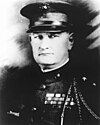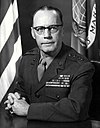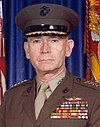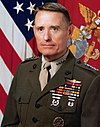Commandant of the United States Marine Corps
| Commandant of the Marine Corps | |
|---|---|
 Emblem of the Marine Corps | |
 Flag of the commandant of the Marine Corps | |
since 22 September 2023 | |
| United States Marine Corps Headquarters Marine Corps | |
| Abbreviation | CMC |
| Member of | Joint Chiefs of Staff |
| Reports to | Secretary of Defense Secretary of the Navy |
| Residence | Marine Barracks, Washington, D.C. |
| Seat | The Pentagon, Arlington County, Virginia, U.S. |
| Appointer | The President with Senate advice and consent |
| Term length | 4 years Renewable one time, only during war or national emergency |
| Constituting instrument | 10 U.S.C. § 8043 |
| Formation | 10 November 1775de facto, 12 July 1798de jure |
| First holder | Samuel Nicholas |
| Deputy | Assistant Commandant of the Marine Corps |
| Website | Official website |
The commandant of the Marine Corps (CMC) is normally the highest-ranking officer in the United States Marine Corps. It is a four-star general position and a member of the Joint Chiefs of Staff.[1] The CMC reports directly to the secretary of the Navy and is responsible for ensuring the organization, policy, plans, and programs for the Marine Corps as well as advising the president, the secretary of defense, the National Security Council,[1] the Homeland Security Council,[1] and the secretary of the Navy on matters involving the Marine Corps. Under the authority of the secretary of the Navy, the CMC designates Marine personnel and resources to the commanders of unified combatant commands.[2] The commandant performs all other functions prescribed in Section 8043 in Title 10 of the United States Code[3] or delegates those duties and responsibilities to other officers in his administration in his name. As with the other joint chiefs, the commandant is an administrative position and has no operational command authority over United States Marine Corps forces.
The commandant is nominated for appointment by the president, for a four-year term of office,[3] and must be confirmed by the Senate.[3] The commandant can be reappointed to serve one additional term, but only during times of war or national emergency declared by Congress.[3] By statute, the commandant is appointed as a four-star general while serving in office.[3] "The commandant is directly responsible to the Secretary of the Navy for the total performance of the Marine Corps. This includes the administration, discipline, internal organization, training, requirements, efficiency, and readiness of the service. The Commandant is also responsible for the operation of the Marine Corps material support system."[4] Since 1806, the official residence of the commandant has been located in the Marine Barracks in Washington, D.C., and his main offices are in Arlington County, Virginia.
The 39th and current commandant is General Eric M. Smith.
Responsibilities
[edit]The responsibilities of the commandant are outlined in Title 10, Section 5043, the United States Code[3] and the position is "subject to the authority, direction, and control of the Secretary of the Navy". As stated in the U.S. Code, the commandant "shall preside over the Headquarters, Marine Corps, transmit the plans and recommendations of the Headquarters, Marine Corps, to the Secretary and advise the Secretary with regard to such plans and recommendations, after approval of the plans or recommendations of the Headquarters, Marine Corps, by the Secretary, act as the agent of the Secretary in carrying them into effect, exercise supervision, consistent with the authority assigned to commanders of unified or specified combatant commands under chapter 6 of this title, over such of the members and organizations of the Marine Corps and the Navy as the Secretary determines, perform the duties prescribed for him by section 171 of this title and other provisions of law and perform such other military duties, not otherwise assigned by law, as are assigned to him by the President, the Secretary of Defense, or the Secretary of the Navy".[3]
List of commandants
[edit]Thirty-nine[5] men have served as the commandant of the Marine Corps. The first commandant was Samuel Nicholas, who took office as a captain,[5] though there was no office titled "Commandant" at the time, and the Second Continental Congress had authorized that the senior-most Marine could take a rank up to Colonel.[6] The longest-serving was Archibald Henderson, sometimes referred to as the "Grand old man of the Marine Corps" due to his 39-year tenure.[5] In the history of the United States Marine Corps, only one commandant has ever been fired from the job: Anthony Gale, as a result of a court-martial in 1820.[5]
| No. | Portrait | Commandant of the Marine Corps | Took office | Left office | Time in office | Notes |
|---|---|---|---|---|---|---|
| 1 | Major Samuel Nicholas (1744–1790) | 28 November 1775 | 27 August 1783 | 7 years, 272 days | The first de facto Commandant for his role as the senior-most officer of the Continental Marines.[7] | |
| 2 | Lieutenant Colonel William W. Burrows (1758–1805) | 12 July 1798 | 6 March 1804 | 5 years, 238 days | The first de jure Commandant, he started many important organizations within the Marine Corps, including the United States Marine Band | |
| 3 | Lieutenant Colonel Franklin Wharton (1767–1818) | 7 March 1804 | 1 September 1818 | 14 years, 178 days | The first commandant to be court-martialed (acquitted) and the first to occupy the commandant's house at the Marine Barracks, Washington, D.C. | |
| - | Major Archibald Henderson (1783–1859) Acting | 16 September 1818 | 2 March 1819 | 167 days | Acting Commandant, would later serve as Commandant from 1820 to 1859 | |
| 4 | Lieutenant Colonel Anthony Gale (unknown–1843) | 3 March 1819 | 8 October 1820 | 1 year, 219 days | The second Commandant to be court-martialed and the only Commandant to be fired. Burial location is unknown and no authenticated images have ever been located. | |
| 5 | Brigadier General Archibald Henderson (1783–1859) | 17 October 1820 | 6 January 1859 | 38 years, 81 days | The longest-serving Commandant; known as the "Grand old man of the Marine Corps"; known for his role in expanding the Marine Corps' mission to include expeditionary warfare and rapid deployment[8] | |
| 6 | Colonel John Harris (1793–1864) | 7 January 1859 | 1 May 1864 | 5 years, 115 days | Commandant during most of the American Civil War | |
| 7 | Brigadier General Jacob Zeilin (1806–1880) | 10 June 1864 | 31 October 1876 | 12 years, 143 days | Became the Marine Corps' first general officer, officially approved of the design of the Eagle, Globe, and Anchor as the emblem of the Marine Corps | |
| 8 | Colonel Charles G. McCawley (1827–1891) | 1 November 1876 | 29 January 1891 | 14 years, 89 days | Chose "Semper Fidelis", Latin for "Always Faithful", as the official Marine Corps motto | |
| 9 | Major General Charles Heywood (1839–1915) | 30 June 1891 | 2 October 1903 | 12 years, 94 days | Chose "Semper Fidelis", Latin for "Always Faithful", as the official Marine Corps motto; he was the first Commandant to reach the rank of Major General | |
| 10 | Major General George F. Elliott (1846–1931) | 3 October 1903 | 30 November 1910 | 7 years, 58 days | Successfully resisted attempts to remove seagoing Marines from capital ships and to merge the Corps into the United States Army | |
| 11 | Major General William P. Biddle (1853–1923) | 3 February 1911 | 24 February 1914 | 3 years, 21 days | Established the Advanced Base Force, forerunner of today's Fleet Marine Force | |
| 12 | Major General George Barnett (1859–1930) | 25 February 1914 | 30 June 1920 | 6 years, 126 days | Served as Commandant during World War I, which caused a huge increase in personnel during his term | |
| 13 | Major General John A. Lejeune (1867–1942) | 1 July 1920 | 4 March 1929 | 8 years, 246 days | Started the tradition of the birthday ball with Marine Corps Order 47, still read annually. Commanded a US Army division (the 2nd Infantry Division) in combat during World War I. | |
| 14 | Major General Wendell C. Neville (1870–1930) | 5 March 1929 | 8 July 1930 | 1 year, 125 days | Recipient of the Medal of Honor and Marine Corps Brevet Medal | |
| 15 | Major General Ben H. Fuller (1870–1937) | 9 July 1930 | 28 February 1934 | 3 years, 234 days | Consolidated the Fleet Marine Force concept | |
| 16 | Major General John H. Russell Jr. (1872–1947) | 1 March 1934 | 30 November 1936 | 2 years, 274 days | The system of seniority promotions of officers was changed to advancement by selection, the 1st Marine Brigade was withdrawn from Haiti, and the number of ships carrying Marine detachments continued to increase. | |
| 17 | Lieutenant General Thomas Holcomb (1879–1965) | 1 December 1936 | 31 December 1943 | 7 years, 30 days | Expanded the Corps almost 20 times in size for World War II and integrated women into the Corps. The first Marine to be advanced (after retirement) to the rank of General | |
| 18 | General Alexander Vandegrift (1887–1973) | 1 January 1944 | 31 December 1947 | 3 years, 364 days | Recipient of the Medal of Honor. Was the first active duty Marine to hold the rank of General, resisted attempts to merge the Corps with the Army | |
| 19 | General Clifton B. Cates (1893–1970) | 1 January 1948 | 31 December 1951 | 3 years, 364 days | Recipient of the Navy Cross. Commandant during early stage of the Korean War. | |
| 20 | General Lemuel C. Shepherd Jr. (1896–1990) | 1 January 1952 | 31 December 1955 | 3 years, 364 days | Recipient of the Navy Cross and last World War I veteran to be Commandant. First Commandant to serve on the Joint Chiefs of Staff. Commandant during the Korean War. | |
| 21 | General Randolph M. Pate (1898–1961) | 1 January 1956 | 31 December 1959 | 3 years, 364 days | Commandant between U.S. involvement in the Korean War and Vietnam War. | |
| 22 | General David M. Shoup (1904–1983) | 1 January 1960 | 31 December 1963 | 3 years, 364 days | Recipient of the Medal of Honor. Opposed U.S. involvement in South Vietnam based on strategy and undue influence of corporations and military officials in foreign policy. Historians consider Shoup's criticisms to be among the most pointed and high-profile leveled by a veteran against the Vietnam War. | |
| 23 | General Wallace M. Greene Jr. (1907–2003) | 1 January 1964 | 31 December 1967 | 3 years, 364 days | Oversaw the expansion of the Corps role in the Vietnam War | |
| 24 | General Leonard F. Chapman Jr. (1913–2000) | 1 January 1968 | 31 December 1971 | 3 years, 364 days | Was the commandant during the final years of U.S. involvement in the Vietnam War. During his period in command, the III Marine Amphibious Force withdrew from Vietnam and the strength of the Corps dropped from a peak of 289,000 to 198,000. | |
| 25 | General Robert E. Cushman Jr. (1914–1985) | 1 January 1972 | 30 June 1975 | 3 years, 180 days | Oversaw the withdrawal of the Marines from Vietnam and a decline in the Corps' peacetime strength to 194,000 | |
| 26 | General Louis H. Wilson Jr. (1920–2005) | 1 July 1975 | 30 June 1979 | 3 years, 364 days | Recipient of the Medal of Honor for capture of Guam | |
| 27 | General Robert H. Barrow (1922–2008) | 1 July 1979 | 30 June 1983 | 3 years, 364 days | Last World War II veteran to be Commandant. Was the first Commandant to serve as a full member of the Joint Chiefs of Staff, acquired approval of production of the American-modified Harrier aircraft, and several other improvements to enhance the effectiveness of the Marine Corps | |
| 28 | General Paul X. Kelley (1928–2019) | 1 July 1983 | 30 June 1987 | 3 years, 364 days | Commandant when the Marine Barracks bombing occurred in Beirut during the 1982–84 multinational force peacekeeping mission under the Reagan Administration. | |
| 29 | General Alfred M. Gray Jr. (1928–2024) | 1 July 1987 | 30 June 1991 | 3 years, 364 days | The Alfred M. Gray Research Center at Marine Corps Base Quantico houses the Marine Corps Archives and Special Collections, the Quantico Base Library, and the research library for the Marine Corps University. As a reminder that the primary role of every Marine is a rifleman, he had his official photograph taken in the Camouflage Utility Uniform, the only Commandant to have done so. Last Korean War veteran to serve as Commandant. | |
| 30 | General Carl E. Mundy Jr. (1935–2014) | 1 July 1991 | 30 June 1995 | 3 years, 364 days | After retirement, he served as president and CEO of the United Service Organizations (USO), and was the chairman of the Marine Corps University Foundation. | |
| 31 | General Charles C. Krulak (born 1942) | 1 July 1995 | 30 June 1999 | 3 years, 364 days | Son of Marine Corps Lieutenant General Victor H. Krulak. Came up with the concept of the 'Strategic Corporal' and the 'Three Block War'. Introduced The Crucible, a final test of Marine recruits. | |
| 32 | General James L. Jones (born 1943) | 1 July 1999 | 12 January 2003 | 3 years, 195 days | Oversaw the Marine Corps' development of MARPAT camouflage uniforms and the adoption of the Marine Corps Martial Arts Program; later became the first Marine officer to serve as Commander, U.S. European Command (USEUCOM) and NATO's Supreme Allied Commander Europe (SACEUR), then as National Security Advisor for the Obama Administration. | |
| 33 | General Michael W. Hagee (born 1944) | 13 January 2003 | 13 November 2006 | 3 years, 304 days | Guided the Corps through the initial years of the Iraq War Last Vietnam veteran to serve as Commandant | |
| 34 | General James T. Conway (born 1947) | 13 November 2006 | 22 October 2010 | 3 years, 343 days | Commanded Marine forces in the Iraq War and oversaw expansion of the Corps to 202,000 personnel. First Commandant in nearly 40 years to have not served in the Vietnam War. | |
| 35 | General James F. Amos (born 1946) | 22 October 2010 | 17 October 2014 | 3 years, 360 days | Oversaw the repeal of the "don't ask, don't tell" policy in the Marine Corps. First naval aviator to serve as Commandant.[9] | |
| 36 | General Joseph Dunford (born 1955) | 17 October 2014 | 24 September 2015 | 342 days | First Commandant and second Marine to be promoted to Chairman of the Joint Chiefs of Staff. | |
| 37 | General Robert Neller (born 1953) | 24 September 2015 | 11 July 2019 | 3 years, 290 days | Led the integration of women into combat roles. Made administrative regulations for Marines on social media. | |
| 38 | General David H. Berger (born 1959) | 11 July 2019 | 10 July 2023 | 3 years, 364 days | Issued guidance for Service-level planning to include refocusing on high-end combat, shifting away from tanks and artillery in favor of long-range missiles and drones. | |
| - | 
|
General Eric M. Smith (born c. 1964) |
10 July 2023 | 22 September 2023 | 74 days | Served as acting commandant after Berger's retirement amid Senator Tommy Tuberville's hold on military nominations, and sworn in following confirmation.[10][11] During his hospitalization after suffering a heart attack, Lieutenant General Karsten Heckl (30 October – 3 November 2023) and General Christopher J. Mahoney (3 November 2023 – 5 March 2024) served as acting commandants. |
| 39 | 22 September 2023 | Incumbent | 1 year, 60 days |
Timeline
[edit]
See also
[edit]- Assistant Commandant of the Marine Corps
- Military Secretary to the Commandant of the Marine Corps
- Sergeant Major of the Marine Corps
References
[edit]Notes
[edit]- ^ a b c 10 U.S.C. § 151 Joint Chiefs of Staff: composition; functions.
- ^ 10 U.S.C. § 165 Combatant commands: administration and support
- ^ a b c d e f g 10 U.S.C. § 5043 Commandant of the Marine Corps
- ^ "Appendix A: How the Marines Are Organized" (PDF). Marine Corps Concepts and Programs 2006. United States Marine Corps. p. 252. Archived (PDF) from the original on 15 May 2008. Retrieved 6 May 2007.
- ^ a b c d "Commandants of the U.S. Marine Corps". Historical Topics: Frequently Requested. Reference Branch, History Division, United States Marine Corps. Archived from the original on 19 December 2011. Retrieved 21 October 2007.
- ^ Journal of the Continental Congress (10 November 1775). "Resolution Establishing the Continental Marines". United States Marine Corps History Division. Archived from the original on 7 October 2010. Retrieved 2 February 2010.
- ^ Hoffman, Col Jon T. (2002). Marine Corps Association (ed.). USMC: A Complete History. Beth L. Crumley (illustration editor), Charles J. Ziga (design), Col John Greenwood (editor), James O. Muschett (editor). Hugh Lauter Levin Associates. ISBN 0-88363-650-6. Archived from the original on 4 May 2009.
- ^ Krivdo, Michael E. (2009). "Harpers Ferry: Last Action of "Henderson Era"". Fortitudine. 34 (4). Quantico, VA: United States Marine Corps Historical Program: 7–11. ISBN 978-0-16-010404-6. Archived from the original on 27 May 2010. Retrieved 1 February 2010.
- ^ Shea, Sgt Jimmy D. (22 October 2010). "Taking the Reins: Marine Corps Welcomes New Commandant". Headquarters Marine Corps. United States Marine Corps. Archived from the original on 26 October 2010. Retrieved 22 October 2010.
- ^ Gould, Joe (21 September 2023). "Senate confirms Army and Marine chiefs, bucking Tuberville logjam". Politico. Archived from the original on 22 September 2023. Retrieved 22 September 2023.
- ^ Loewenson, Irene (23 September 2023). "Top Marine leader sworn in 1 day after Senate confirmation". Marine Corps Times. Archived from the original on 22 September 2023. Retrieved 23 September 2023.
Sources
[edit] This article incorporates public domain material from websites or documents of the United States Marine Corps.
This article incorporates public domain material from websites or documents of the United States Marine Corps.- Millett, Allan Reed; Shulimson, Jack, eds. (2004). Commandants of the Marine Corps. Annapolis, Md.: Naval Institute Press. ISBN 978-0-87021-012-9.
- Ulbrich, David J. (2011). Preparing for Victory: Thomas Holcomb and the Making of the Modern Marine Corps, 1936–1943. Naval Institute Press. ISBN 978-1591149033.
External links
[edit]










































